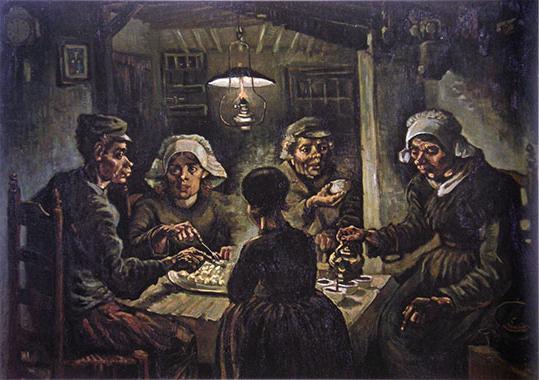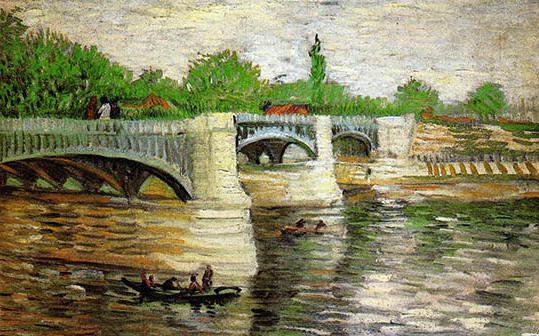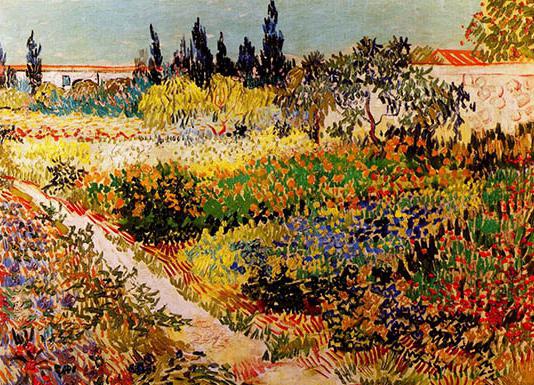The short life of this artist was like a bright flash of lightning. Vincent Van Gogh lived for only 37 years, but left behind a fantastically huge creative heritage: more than 1700 works, among which about 900 drawings and 800 paintings. At modern auctions, Van Gogh’s paintings beat all records at a cost, but in life he managed to sell only one of his work, which, in terms of today's money, brought him an income of only $ 80. The controversial emotional personality of the artist and his unusual work were incomprehensible to most contemporaries.
Now, many books have been written about the biography of the illustrious Dutchman, and his paintings and drawings take pride of place in the most prestigious art museums and galleries in the world. Let us recall the creative path of the great expressionist and the magnificent Van Gogh paintings, unlike any other.
Three creative periods in the artist's life
Vincent Van Gogh’s creative career is conditionally divided by art critics into three periods: Dutch (1881-1886), Paris (1886-1888) and later, which lasted from about 1888 until the artist’s death in 1890. Such a short creative life, only 9 years long, was destined for this person. Canvases written in these time periods vary greatly between each other and the plot and manner of writing. I would like to clarify that the paintings of Van Gogh, the names of which are indicated in this article, of course, are only a small part of his vast artistic heritage.
Vincent Van Gogh began his creative work much earlier than 1881, but then he was mainly attracted to graphic drawing. He did not receive a professional art education, although he tried several times to study as an artist. But he could not overcome the rebellious spirit in himself, his talent could not fit into any academic framework, which forced the young Vincent to drop out of school and do painting on his own.
Wag Gogh paintings of the Dutch period
Having discovered oil painting for himself , the artist first of all began to paint people, their harsh life, hard life. The canvases of this period do not at all look like the bright beautiful creations of Van Gogh, which later brought him deafening posthumous fame. Here are the characteristic works of those years: "Potato Eaters", "Weaver", "Peasant Woman". The color palette of these paintings is dark and gloomy, like the very life of poor people.

It can be seen how the artist ardently empathizes with his characters. Van Gogh had a very responsive, kind and compassionate soul. In addition, he was very religious, for some time he even served as a Christian preacher. All the commandments of the New Testament he understood literally. He wore the simplest clothes, ate poorly and lived in the poorest shacks. Moreover, he came from a very wealthy family and if he wanted, he could continue his family business (trade in paintings and art objects). But Vincent Van Gogh was not like that; he was good at painting, but not selling.
Paris period
In 1886, Van Gogh forever leaves his native Holland and comes to Paris, where he tries to study painting, attends exhibitions of fashionable painters, and gets acquainted with the work of the Impressionists. The paintings of Toulouse Lautrec, Monet, Pizarro, Signac, Renoir made a huge impression on Van Gogh and had a considerable influence on the further formation of his creative manner of writing. Van Gogh begins to pay great attention to color, now he is attracted not only by people, but also by landscapes and still lifes. The artist’s palette becomes brighter and brighter, Van Gogh’s talent as a great colorist begins to appear in the works of the Paris period.

In Paris, the artist works as obsessed, however, as always. Here are some typical Wag Gogh paintings painted at that time: “Sea in Saint Mary”, “Bouquet of Flowers in a Blue Vase”, “Seine Embankment with Boats”, “Still Life with Roses and Sunflowers”, “Branch of Blooming Almonds”, “ Kitchen gardens in Montmartre, “Roofs of Paris,” “Portrait of a Woman in Blue,” etc. The Paris period of Van Gogh was very fruitful; during these years, the artist painted about 250 paintings. Then Van Gogh met Gauguin, their friendship and creative union became very valuable to him. But the characters of the two creators are too dissimilar. And it all ends in a quarrel that leads Vincent to a nervous breakdown. It is to this difficult period of life that Van Gogh's painting "Self-portrait with a Cut Off Ear and Tube" refers.
Van Gogh's work in Arly
Gradually noisy Paris begins to weigh Van Gogh, and in the winter of 1888 he leaves for Provence, in the town of Arles. Here he was to write his most brilliant creations. The beautiful nature of these places fascinates the artist. One after another, he creates canvases such as "Landscape with a Road, a Cypress and a Star", "Rocks in Provence", "Red Vineyards", "Olive Trees Against the Background of Alpilla", "Harvest", "Field of Poppies", "Mountains in Saint-Remy "," Cypress "and many other incomparable landscapes - masterpieces of post-impressionist painting.

And he writes endless series of floral still lifes. No one ever painted flowers like Vincent Van Gogh. Paintings - the famous "Sunflowers" and "Irises" - were painted by him in Provence. The artist brings to the canvas endless fields of Provence filled with clear transparent air, flowering gardens, cypress trees, luxurious olive groves. At the same time, he is also an excellent portrait painter. In Arles, he painted many portraits and self-portraits.
Famous "Sunflowers"
Still life "Sunflowers" is one of the most popular paintings by Van Gogh. Most of us know this canvas from numerous reproductions. And meanwhile, the impressionist was not the only one to write this still life, but a whole cycle of seven paintings that depicted sunny flowers. But one of the works died in Japan during the atomic bombing, the other was lost in one of the private collections. Thus, only 5 paintings from this series have survived to this day.
These are the pictures of Van Gogh. The description and photograph of the reproduction, of course, cannot convey the whole charm of the original. And still I want to devote a couple more lines to “Sunflowers”. This still life just splashes with sunlight! Van Gogh surpassed himself by finding many shades in yellow. Some researchers believe that the artist manifested mental illness in this work, as evidenced by this unusual brightness and saturation of the still life.
Painting "Starry Night"
Van Gogh's painting "Night", or rather, "Starry Night", was painted by him in Saint-Remy, in 1889. This is a large canvas measuring 73x92 cm. The color scheme of this fantastic creation of the artist is very unusual - a combination of blue, sky, dark blue and green with various shades of yellow.
The compositional basis is dark cypress trees in the foreground, a small inconspicuous town lies in the valley, and above it stretches an endless restless sky with exaggeratedly huge stars and a luminous moon, as if twisted in a whirlwind of the Milky Way. This picture, like most of Van Gogh’s works, needs to be watched, moving a decent distance, it is impossible to perceive integral large strokes close by.
Canvas "Church in Auvers"
Van Gogh's painting "The Church in Auvers" is also one of his most famous and popular works. This work was written in the last year of the painter's life, when he was already very sick. Van Gogh suffered from a severe mental disorder, which could not but affect his painting.
The drawing of the church, which is the center of the composition, is made with wavy, trembling lines. The sky - heavy, dark blue - as it hangs over the church and presses on it with its leaden weight. The viewer associates it with a certain impending threat, awakens anxious feelings in the soul. The lower part of the picture is bright, it shows a bifurcated path and grass illuminated by the sun.
Cost of paintings
As mentioned earlier, the cost of the work of the Dutch post-impressionist is very high. But even having a huge amount of money, it will be difficult to buy a canvas, authored by the great Van Gogh himself. Pictures with the names "Sunflowers" at the moment can be evaluated in any mega-large amount. In 1987, one of the paintings of this cycle at the Christie's auction was sold for $ 40.5 million. Since then, a lot of time has passed, but because the cost of this work could grow many times.
The picture "Arlesian" went off the auction "Christie" in 2006 for 40.3 million, and "Peasant Woman in a Straw Hat" was bought in 1997 for $ 47 million. If the artist could survive to this day, he would be one of the richest people on earth, but he died in poverty, not even knowing how much future generations would appreciate his work.
The artworks in Russia
In Russia, Van Gogh’s paintings can be seen in St. Petersburg, in the Hermitage, as well as in Moscow, at the Museum of Fine Arts. Pushkin. In total, there are 14 Van Gogh's works in our country: "Arena in Arles", "Huts", "Morning", "Landscape with a House and a Plowman", "Portrait of Ms. Trabuc", "Boats at Sainte-Marie", "White house at night "," Arles ladies "," Bush "," Prisoners' walk "," Portrait of Dr. Felix Rey "," Red vineyards in Arles "," Landscape in Auvers after the rain. "